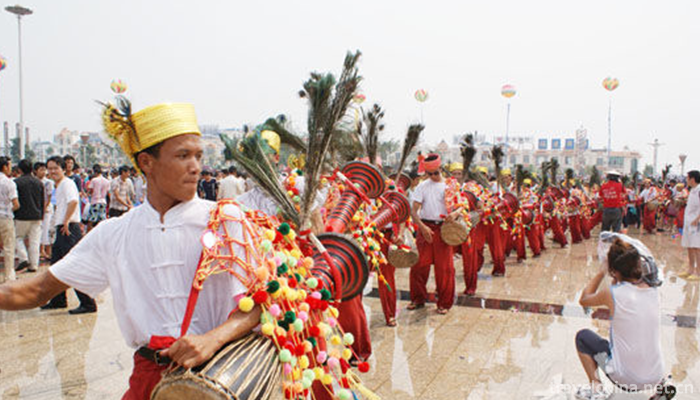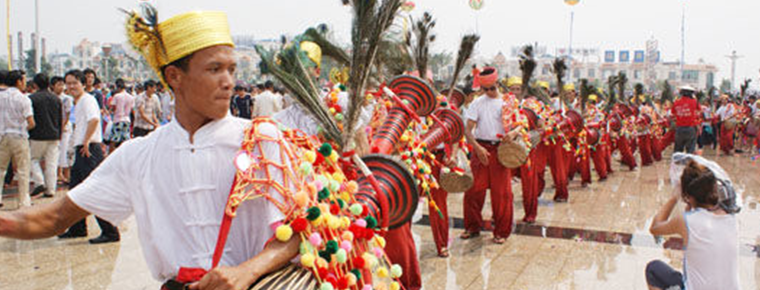Dai Elephant Foot Inspiration
Dai Elephant Foot Inspiration
There is also a legendary story about the origin of the Dai elephant drum. Legend has it that Mengzhai area in ancient times was a beautiful lake rippling with blue waves. But there are pythons and tortoises on the lakeside. They make misdeeds everywhere and devour human beings and animals. Later, a Dai warrior came to the lake with a group of hunters, destroyed the pythons that devoured human beings and animals, and took skins to knock on hollow trees and bamboo barrels for pleasure, thus forming drums. A few years later, two elephant tamers changed the drum into the shape of feet and legs. Since then, elephant foot drums have appeared in Dai people. Among the numerous Dai folk dances, "elephant foot drum" can be said to be more representative.
On June 7, 2008, the Dai elephant foot drum was listed in the second batch of national intangible cultural heritage list with the approval of the State Council.
Historical evolution
Dai elephant foot drum dance has a long history, fast rhythm, changeable, artistic expression and appeal. In 2006, it was listed in the first batch of intangible cultural heritage protection list of Yunnan Province by the Yunnan Provincial Government, and in 2008, it was listed in the second batch of national intangible cultural heritage by the State Council.
The elephant foot drum of the Dai nationality is an ancient national musical instrument of the Dai nationality. The book Biography of Baiyi written by Qian Guxun, a Ming Dynasty man, says that the Dai people "take sheep's skin as three or five long drums and pat them with their hands". The "three and five long drums" here refer to the elephant foot drums, which are three to five feet in length. It can be seen that before the Ming Dynasty, the Dai people had elephant foot drums.
About the origin of elephant foot drum, there is a very interesting story among Dai people. It is said that long ago, the Dai people suffered from annual floods, and people were not allowed to live and work in peace and contentment. Later, it was known that it was a dragon who did evil. Everyone hated Jiaolong. There was a brave Dai youth who was determined to fight for the people. With the help of his villagers, he finally killed Jiaolong. In celebrating the victory, people, in order to express their hatred for the evil dragon and their longing for a happy life, peeled off the skin of the dragon and imitated the feet of the white elephant, which symbolized good luck. From then on, the sound of footdrums rang through the Dai villages, expressing the joy of the Dai people. In the eyes of the Dai people, elephants in beasts and peacocks in birds are regarded as symbols of auspiciousness. Therefore, when the elephant drum sounds, men, women, old and young all dance happily.
Elephant foot drum dance is one of the most popular and distinctive mass male dances in Dai dance. Because of the elephant foot inspiration, so the name elephant foot inspiration. Elephant foot drum plays an important role in Dai's cultural life. Every spare time, festivals or drum contests, young men with feet like drums come from villages and dance vigorous, thick and flexible elephant feet to inspire them. Where is the sound of drums like feet? There are happy people everywhere.
Style and characteristics
Dai elephant foot drum is divided into three kinds: long elephant foot drum, medium elephant foot drum and small elephant foot drum. Elephant foot drum dancing movements are not much, with a variety of playing methods, drum points are rich. There are hand-to-finger, two-finger, three-finger, palm, punch, elbow, even foot, head, mostly for one person performance, or dance accompaniment. Mid-elephant drums are usually punched with fists and hammers are used in individual areas. It does not have more drum points, usually a beat, individual areas of the left finger with a weak beat. The standard is the length of drum, the timbre level and the size of drum tail swing when dancing. It is said that the elder drummer can play a hammer drum to unlock all the buttons of his clothes, and then a hammer drum to button all the buttons, the drumming is still incomplete. The middle elephant foot drum steps are firm, steady and vigorous, and there are many big movements and dancing gestures. When dancing, there is no limit to the number of people. When people are small, they fight in circles. When people are large, they fight in circles. Elephant foot drums are common only in Xishuangbanna. They dance flexibly and are characterized by fighting drums and playing drums. In the battle and match, we win by flexible, witty attack, concession and finally grabbing the opponent's hat or Baotou. Generally, it is a two-person match .
The elephant foot drum dance is the main accompaniment instrument of Dai dance besides its rich and colorful dance. As long as people hear drums, they can't help shaking and dancing. When accompanying peacock dance, they form unique drums. For example, when elephant foot drums beat "about breaking down, about breaking down, about breaking down and about joining Jolie", that is to say, "well lift, well lift wings." Peacock dancers hear this drumming point, that is, do the movement of lifting wings.
In order to make the drum sound rounded, soft and prolonged, rice balls rubbed with glutinous rice must be glued on the drum surface before playing. The long elephant drum, the small elephant drum and the middle elephant drum in some areas stick to the center of the drum, while the middle elephant drum sticks to a circle about seven centimeters in diameter. In addition, in order to beautify and increase the swing range of the drum tail, some middle elephant feet are decorated with clusters of peacock feathers on the drum tail.


-
1.Shika Snow Mountain
Sheka snow mountain scenic area is located in the southwest of Jian Tang town in Shangri-La County
Time 2018-10-19 -
2.Zhashlenbu Temple Scenic Spot in Shigaze
Zashrunbu Temple means "auspicious Xumi Temple". Its full name is "Zashrunbu Baijid Qinqu Tangkelenan Bajawalin". It means "auspicious must gather in Fushu to win over Fangzho
Time 2018-12-12 -
3.Liu Jiawan Chaihai Garden
Located on the eastern coast of Taolu Town, Donggang District, Rizhao City, Liujiawan Chaihai Garden is a national AAAA-level tourist attraction, a popular science education base, and a core scenic sp
Time 2018-12-26 -
4.Gesara Ecotourism Scenic Area
Gesala Ecotourism Area is located in Yankou Township, Waluo Township, Hot Spring Township and Qinghe Township in the northwest of Yanbian County, Panzhihua City. It is located at the junction
Time 2019-01-12 -
5.Tianhe mountain
Tianhe Mountain, located in Xingtai City, Hebei Province, is China's Love Mountain, the hometown of Chinese Qixi Culture, and the birthplace of the legend of Cowherd and Weaver Girl
Time 2019-02-21 -
6.Korean Springboard and Swing
Springboards and swings are the most popular traditional folk sports for Korean women, and they have a broad mass character.
Time 2019-04-16 -
7.Dong Brocade Weaving Techniques
Dong brocade weaving technology, the traditional handicraft of Tongtong Dong Autonomous County in Hunan Province, is one of the national intangible cultural heritage.
Time 2019-04-27 -
8.Ewenke to seize the pivot
Pivot-snatching is a traditional competitive event of Ewenki nationality. It was performed by the representative team of Inner Mongolia Autonomous Region in the 6th National Minority Traditional Sport
Time 2019-04-28 -
9.Liang Pings Gong and drum
Liangping Gong and drum is a kind of traditional folk instrumental music spread in Liangping District of Chongqing. In Liangping, the predecessors said that "Shu people Chao shan, gongs and drums
Time 2019-05-13 -
10.Legend of Liu Bowen
Liu Bowen's legend is based on the traditional folk oral literature of Liu Ji, a historical figure, spread throughout the whole country in eastern Zhejiang, with Qingtian, Wencheng and other southern
Time 2019-05-13 -
11.Ying Luohan
Yingluohan is a form of traditional folk entertainment which integrates martial arts and folklore in the traditional festival activities in Jinyun County, Zhejiang Province. This kind of activity also
Time 2019-07-14 -
12.Chengdu Yongling Museum
The Royal Museum of Wang Jian, located at No.10 Yongling Road, Jinniu District, Chengdu, covers a total area of 54000 square meters, and is composed of three parts: cultural relics protection area, comprehensive museum and garden protection area.
Time 2020-10-18